6 Ways Ecommerce Fashion Sites Build Personalization into the UX

To kick off our conversation about how fashion sites build personalization into the UX, let’s be sure to emphasize the phrase, build into. Personalization needs to be integrated into your site, as well as into your long-term ecommerce strategy. It’s not something to add on after the fact. Personalization creates an experience unique to your customers, and it keeps them coming back.
To share what we mean by this, here are 6 ways apparel and accessory sites have worked personalization into their site experience. Let’s take a look.
1. Tenth Street Hats: Virtual try-ons

When looking at a garment or accessory to buy, the main question people ask is, “How will this look on me?” Until recently, that’s been a tough question to answer in ecommerce. More and more, however, innovative retailers are developing new ways to help online shoppers see themselves in the “mirror.”
To offer this kind of personalization, Daniel Beauchamp, the Head of AR/VR at Shopify, advises retailers to begin with making 3D models of their products. (Or working with a partner to do so.) Tenth Street Hats, a merchant on Shopify, has taken his advice. Customers can now try on hats for themselves using augmented reality. The experience begins on the landing page as shoppers are invited to explore the Tenth Street hat collection in 3D. It’s super easy to activate the virtual try-on with a FaceTime camera and one click. The camera recognizes the shopper’s face, and places the selected hat on their head. Yes, this technology is in its early stage. Yet it’s easy to imagine it will become ubiquitous for accessory sites before too long.
2. Isabella Oliver: Quiz offers specific help
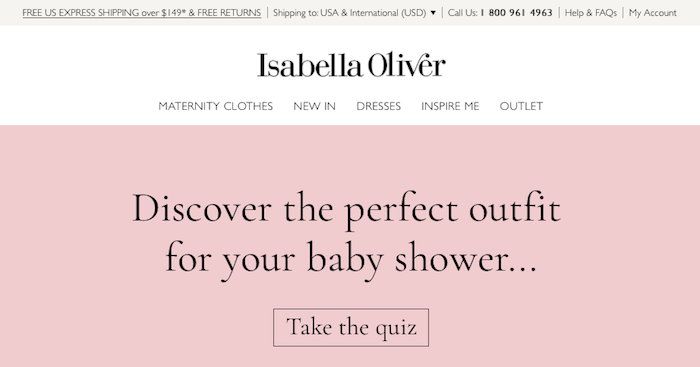
Quizzes are one of the easiest, most effective ways to build rapport with your customers. In effect, quizzes are conversation starters, and like any good conversation, you can learn a lot about the other person. For online clothing retailers, quizzes are particularly useful to help customers determine the right sizing. Further, once customers know their perfect fit in your brand of clothing, they become more likely to keep returning to purchase more.
Isabella Oliver, a maternity retailer from the U.K., has built personalization into their quiz. They do so by asking about an event most of their shoppers are planning: What are you going to wear to your baby shower? The questionnaire prompts users about the kind of event (casual or dressy) along with a few other quick inquiries. Based on the customer’s answers, the site suggests outfits for the upcoming shower. This quiz is a winner because they’ve solved a very specific issue for their customers. Nicely done.
3. Guess: The stylist without the subscription
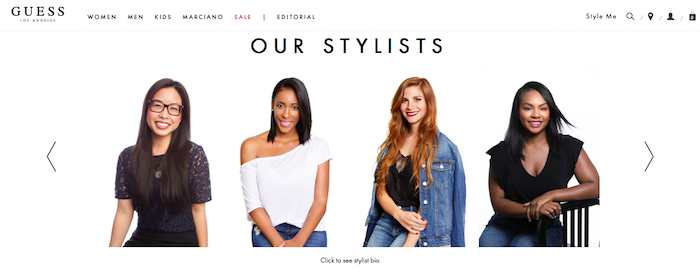
Not too long ago, Stitch Fix ushered in the era of online personalization through their subscription service. The site asks shoppers dozens of questions up front, and then curates purchases for them. The longer a customer subscribes, the better the retailer gets to know them. As a personal Stitch Fix user, I’ve gotta say it’s a very cool service.
But many retailers may not want to invest in the backend operations that subscriptions require. To them, I say, check out Guess. They have launched a personal stylist service. Customers can use it as little or as much as they wish. No matter what, Guess gains lots of new customer data with every registration.
The Guess Personal Stylist service begins with a quiz, and then one of their in-house stylist emails the customer with a suggested outfit. Customers can then purchase any item in the outfit or not. They can also email the stylist to discuss what they like about it and what they don’t. This is like a great way to offer personalization without the long-term commitment of a subscription service.
4. Frank and Oak: The subscription hybrid
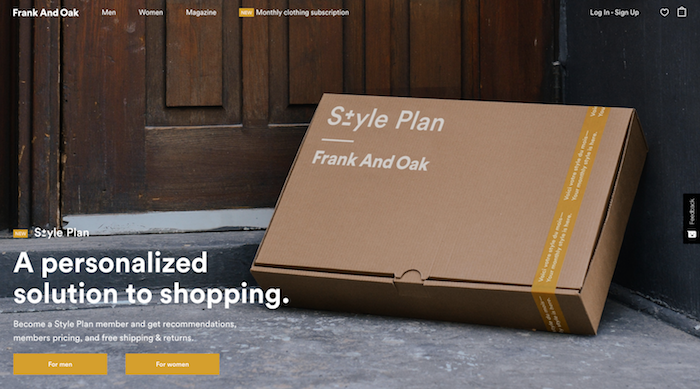
Speaking of offering personalized recommendations in a new way, Frank and Oak recently debuted a monthly box subscription called Style Plan.
There are several interesting aspects to their approach. First and foremost, they have retained their online store, and added the box subscription to it. (Often retailers do one or the other.) Now Frank and Oak has a hybrid business–it’s both a traditional ecommerce company and a subscription service.
Secondly, if you enroll in the Style Plan, you get 20% off regularly-priced items in the box. In other words, there’s an incentive to become a subscriber, rather than order items one-by-one. (Think Amazon Prime for a clothing retailer.)
Also customers can preview their box before it goes out. (Note: this isn’t possible with Stitch Fix, for example.) If a customer doesn’t like something the stylist put in the box, they can substitute it with something else. Imagine how useful this is for Frank and Oak for engaging in conversations with their buyer. Not only are they learning what the customer likes and doesn’t, they are also increasing the chance that they will purchase more items in the box once it arrives. Super smart.
5. Taylor Stitch: Crowdsourcing new products
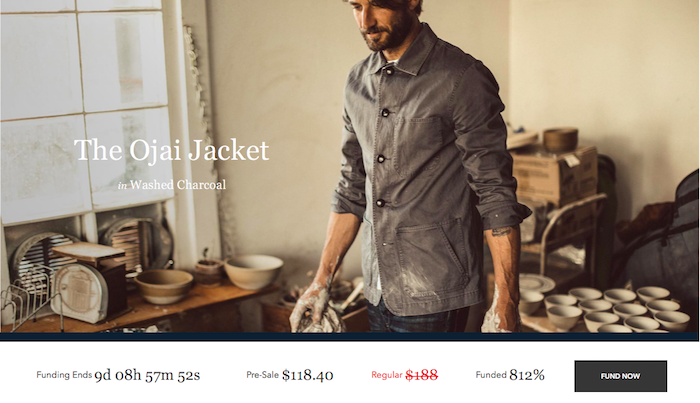
Taylor Stitch offers personalization through their Workshop feature before a product is even made. Here’s how it works: Taylor Stitch posts a new garment, such as the Ojai Jacket above. Customers on the site can “fund” the item, or in other words, pre-order it. In doing so, they get a 20% discount on the garment before it comes available. The company says they have launched 579 products this way. And counting.
For their part, Taylor Stitch gets a very helpful temperature read on a product’s appeal. If the garment gains momentum, they’ll make more of it. If it’s less popular, they will reduce production. In their own words, as a result, “our planet takes on less waste.” I’m all for it. I’m also really impressed by how customers get to voice their personal opinion on upcoming styles. They get to feel a part of the process, and no doubt, they keep coming back to build new products with Taylor Stitch.
6. Anthropologie: Shipping plan based on customer location
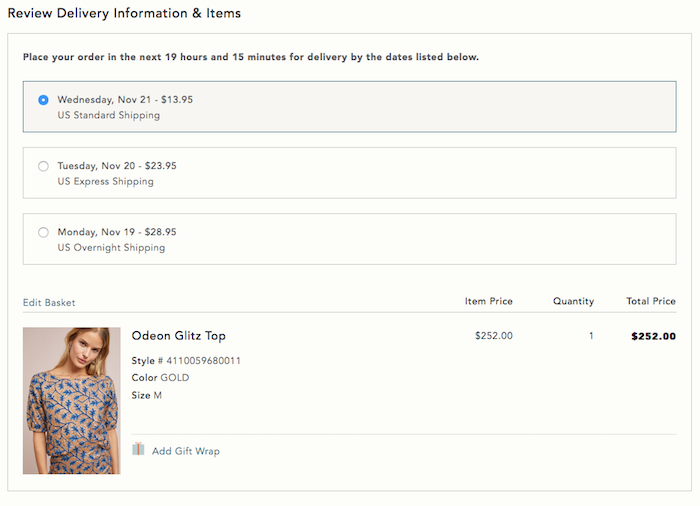
Shipping is the final step in most ecommerce sales, and it’s tempting to overlook it because it’s routine. But accurately estimating shipping times, based on a customer’s location, is key to proving a personalized experience. Please don’t be vague here. Do the work on the backend to be able to communicate exact arrival dates.
eMarketer recently reported that 91% of shoppers worry about late deliveries. Additionally, more than half of the online shoppers surveyed were disappointed during their holiday shopping last year. Shipping issues were the number one reason.
Sure, natural events such as snowstorms, can interfere with precise dates. In that event, communicate shipping updates early and regularly. Customers want their purchase. They are making plans based on its arrival. Often, especially over the holidays, a day or two makes a big difference.
In the example above, Anthropologie has outlined the cost and timeline for three different shipping methods. The options vary only by one day, yet that day could mean the shopper gets to wear her new Odeon Glitz Top to the office holiday party or not. Retailers have everything to gain by helping customers make their plan through offering accurate shipping information based on specific customer location.
Are you thinking about integrating more personalization into your site UX? As we see here, there are several easy ways to do so, including virtual try-ons, helpful quizzes, personal stylists, new takes on subscriptions, crowdsourcing, and shipping accuracy. Which one of these approaches would be best for your business–or better yet, which combination of these features? Drop us a line, and we can help you determine the best strategy for your ecommerce fashion site.
